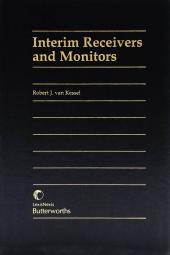Interim Receivers and Monitors
One Year Subscription Only Terms
Subscribers receive the product(s) listed on the Order Form and any Updates made available during the annual subscription period. Shipping and handling fees are not included in the annual price.
Subscribers are advised of the number of Updates that were made to the particular publication the prior year. The number of Updates may vary due to developments in the law and other publishing issues, but subscribers may use this as a rough estimate of future shipments. Subscribers may call Customer Support at 800-833-9844 for additional information.
Subscribers may cancel this subscription by: calling Customer Support at 800-833-9844; emailing customer.support@lexisnexis.com; or returning the invoice marked 'CANCEL'.
If subscribers cancel within 30 days after the product is ordered or received and return the product at their expense, then they will receive a full credit of the price for the annual subscription.
If subscribers cancel between 31 and 60 days after the invoice date and return the product at their expense, then they will receive a 5/6th credit of the price for the annual subscription. No credit will be given for cancellations more than 60 days after the invoice date. To receive any credit, subscriber must return all product(s) shipped during the year at their expense within the applicable cancellation period listed above.
Product description
An Easy Reference for all Insolvency Professionals
Interim receivers and monitors are the eyes and ears of the courts. Judges, debtors, creditors, and other stakeholders rely on them for dedicated expertise and independence.
Balancing these competing demands can be further complicated by the courts' discretionary power to expand or contract your functions. Plus, insolvency law changes at a fast and furious pace.
Butterworths Interim Receivers and Monitors has the most up-to-date coverage of this burgeoning field. "Tourists" to the insolvency world occasionally will gain a broad overview of the roles of interim receivers and monitors. Advanced practitioners will benefit from specific information about particular points of law.
Answers to Your Most Important Questions
Part I: Interim Receivers
- When do courts make interim receivership orders
- What are the functions of interim receivers in petitions, proposals, and 244 Notice Contexts
- How can you ensure immunity from liability for breach of duty, successorship and other liabilities
- How can you ensure "fair and reasonable" costs for taxation
- How Bill C-55 may change the scope of interim receiver powers and duties
- When do courts appoint CCAA monitors
- What are the powers and duties of CCAA monitors
- How can breach of fiduciary duties and other liabilities be avoided
- How does Bill C-55 widen prescribed functions
- What penalties do courts impose for undisclosed conflicts of interest
- What research must be conducted to prepare for a receivership
- What must be disclosed to courts before accepting a receivership
- How can conflicts of interest be avoided during an appointment
- Interim Receivers and Monitors contains extensive excerpts from case law plus:
- Excerpts of the Bankruptcy and Insolvency Act and BIA Rules Affecting Interim Receivers
- Sample Section 46 Interim Receivership Order
- Sample Order in a Proposal or 244 Notice Context
- Companies' Creditors Arrangement Act
- CCAA Initial Order (for Monitoring Functions)
- BIA Code of Ethics for Trustees
- Comparison Between Bill C-55 and Current Provision of the BIA and CCAA
Table of contents
PART I: INTERIM RECEIVERS
Introduction
Chapter 1: Historical Developments
Chapter 2: Appointment of Interim Receivers
Chapter 3: Functions of Interim Receivers
Chapter 4: Liability Issues
Chapter 5: Costs
Chapter 6: Bill C-55 and Interim Receivers
PART II: CCAA MONITORS
Introduction
Chapter 1: CCAA
Chapter 2: Appointment of CCAA Monitors
Chapter 3: Functions of CCAA Monitors
Chapter 4: Selected Liability Issues
Chapter 5: Costs
Chapter 6: Bill C-55 and the Monitor's Role
PART III: CONFLICT OF INTEREST
Introduction
Chapter 1: Law of Conflict of Interest
Chapter 2: Judicial Perspectives on Conflict of Interest
Chapter 3: Professional Guidance
Appendices
1. Excepts of BIA and BIA Rules Affecting Interim Receivers
2. Sample Interim Receivership Order Under S.46 of BIA
3. Sample Order in a Proposal or 244 Notice Context
4. CCAA
5. Sample CCAA Initial Order for Monitoring Functions
6. BIA Code of Ethics for Trustees
7. Comparison Between the Old Law and the New Law
Related products
-
 The Law of Fraud in CanadaRelease date: September 30, 2013$340.00
The Law of Fraud in CanadaRelease date: September 30, 2013$340.00 -
 Dispositions Without Trial, 3rd EditionRelease date: March 18, 2019$370.00
Dispositions Without Trial, 3rd EditionRelease date: March 18, 2019$370.00 -
New!
 Canadian Immigration & Refugee Law Practice, 2025 Edition (Volume 1) + Related Materials (Volume 2) + E-BookNew!Release date: November 14, 2024$205.00
Canadian Immigration & Refugee Law Practice, 2025 Edition (Volume 1) + Related Materials (Volume 2) + E-BookNew!Release date: November 14, 2024$205.00
 Lexis Nexis
Lexis Nexis 